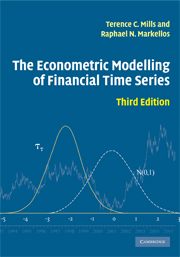Book contents
- Frontmatter
- Contents
- List of figures
- List of tables
- Preface to the third edition
- 1 Introduction
- 2 Univariate linear stochastic models: basic concepts
- 3 Univariate linear stochastic models: testing for unit roots and alternative trend specifications
- 4 Univariate linear stochastic models: further topics
- 5 Univariate non-linear stochastic models: martingales, random walks and modelling volatility
- 6 Univariate non-linear stochastic models: further models and testing procedures
- 7 Modelling return distributions
- 8 Regression techniques for non-integrated financial time series
- 9 Regression techniques for integrated financial time series
- 10 Further topics in the analysis of integrated financial time series
- Data appendix
- References
- Index
1 - Introduction
Published online by Cambridge University Press: 05 June 2012
- Frontmatter
- Contents
- List of figures
- List of tables
- Preface to the third edition
- 1 Introduction
- 2 Univariate linear stochastic models: basic concepts
- 3 Univariate linear stochastic models: testing for unit roots and alternative trend specifications
- 4 Univariate linear stochastic models: further topics
- 5 Univariate non-linear stochastic models: martingales, random walks and modelling volatility
- 6 Univariate non-linear stochastic models: further models and testing procedures
- 7 Modelling return distributions
- 8 Regression techniques for non-integrated financial time series
- 9 Regression techniques for integrated financial time series
- 10 Further topics in the analysis of integrated financial time series
- Data appendix
- References
- Index
Summary
The aim of this book is to provide the researcher in financial markets with the techniques necessary to undertake the empirical analysis of financial time series. To accomplish this aim we introduce and develop both univariate modelling techniques and multivariate methods, including those regression techniques for time series that seem to be particularly relevant to the finance area.
Why do we concentrate exclusively on time series techniques when, for example, cross-sectional modelling plays an important role in empirical investigations of the capital asset pricing model (CAPM; see, as an early and influential example, Fama and MacBeth, 1973)? Moreover, why do we not address the many issues involved in modelling financial time series in continuous time and the spectral domain, although these approaches have become very popular, for example, in the context of derivative asset pricing? Our answer is that, apart from the usual considerations of personal expertise and interest plus constraints on manuscript length, it is because time series analysis, in both its theoretical and empirical aspects, has been for many years an integral part of the study of financial markets.
The first attempts to study the behaviour of financial time series were undertaken by financial professionals and journalists rather than by academics. Indeed, this seems to have become a long-standing tradition, as, even today, much empirical research and development still originates from the financial industry itself. This can be explained by the practical nature of the problems, the need for specialised data and the potential gains from such analysis.
- Type
- Chapter
- Information
- Publisher: Cambridge University PressPrint publication year: 2008



